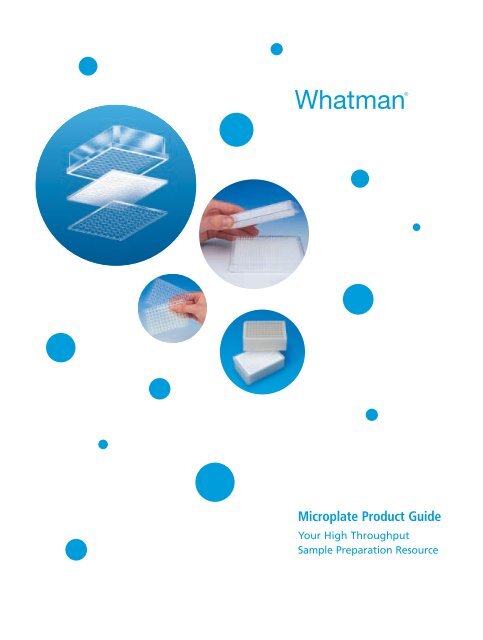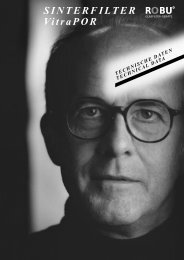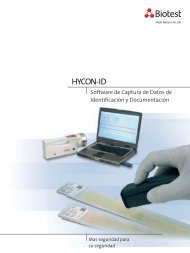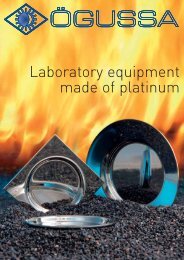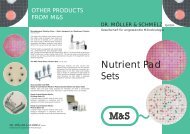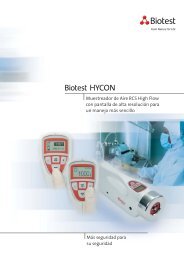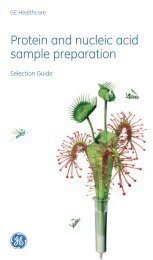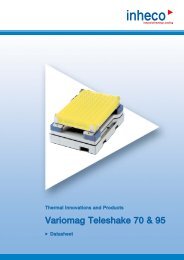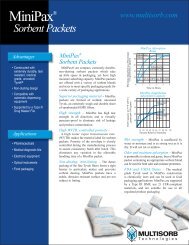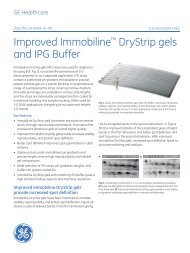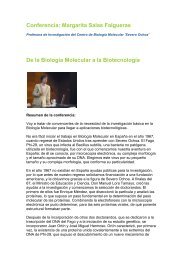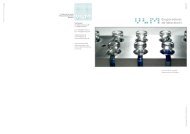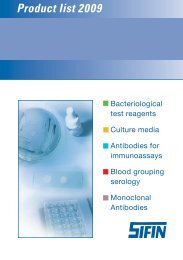Microplate Product Guide - Whatman
Microplate Product Guide - Whatman
Microplate Product Guide - Whatman
You also want an ePaper? Increase the reach of your titles
YUMPU automatically turns print PDFs into web optimized ePapers that Google loves.
<strong>Microplate</strong> <strong>Product</strong> <strong>Guide</strong>Your High ThroughputSample Preparation Resource
<strong>Microplate</strong> <strong>Product</strong> <strong>Guide</strong>Your High ThroughputSample Preparation ResourceAt <strong>Whatman</strong>, our primary focus is the application of filtrationseparation technology in multiwell devices. We utilize aunique proprietary process to encapsulate the filter mediawhich ensures no crosstalk or contamination between wells.This proprietary technology allows us to use a variety of<strong>Whatman</strong> filter media, as well as high quality media fromother manufacturers. In addition, to further optimize<strong>Whatman</strong> UNIFILTER ® microplates for specific applications,we incorporate novel polymers, surface treatments, welldensities, profiles and accessories.<strong>Whatman</strong> also manufactures an assortment of microplatesfor sample collection, analysis, storage and reservoirapplications. As a result, we can offer the widestselection of microplates available from a single source.UNIFILTER microplates are available in 24, 96 and 384 wellconfigurations. Collection/storage microplates are availablein 24, 48, 96 and 384 well configurations in various welldesigns as well as polymers. Most <strong>Whatman</strong> microplateswith or without filters conform to ANSI/SBS* standards.Contents<strong>Microplate</strong> Selection <strong>Guide</strong> . . . . . . . . . . . 5Drug Discovery . . . . . . . . . . . . . . . . . . . . . 7Nucleic Acid Purification . . . . . . . . . . . . 10Immunology . . . . . . . . . . . . . . . . . . . . . . .13UNIFILTER Filtration <strong>Microplate</strong>s . . . . . . 14UNIPLATE Collectionand Analysis <strong>Microplate</strong>s . . . . . . . . . . . . 18Specialty <strong>Microplate</strong>s . . . . . . . . . . . . . . . 20Seals and Lids . . . . . . . . . . . . . . . . . . . . . 22Accessories . . . . . . . . . . . . . . . . . . . . . . . 24Filter Selection <strong>Guide</strong> . . . . . . . . . . . . . . . 26Our focus on microplate technology is applied by a teamof engineers, scientists, polymer engineers and filtrationexperts to ensure we are at the leading edge of newdevelopments. In terms of technology, we are your highthroughput sample preparation resource.* ANSI is the American National Standards Institute and SBS is the Society of Biomolecular Screening.2 <strong>Microplate</strong> <strong>Product</strong> <strong>Guide</strong>
UNIFILTER Filtration<strong>Microplate</strong>s(p. 14-17)<strong>Whatman</strong> UNIFILTER filtration microplates,which are produced in standard 24, 96 or384 well formats, have a filter or membraneencapsulated in the base of each well.All filtration microplates are available withmatched collection plates and a range ofaccessories for sample preparation, handlingand storage.<strong>Whatman</strong> offers filtration microplatesproduced from clear as well as whitepolystyrene for use in high throughputbiological assay screening applications.These plates have a shallow well so thatthe encapsulated filter or membrane isclose to the detection system. This isimportant for sensitivity, particularly withweak or short-range events. A wide rangeof filtration media to suit most biologicalassays is available from stock.100 µL for 384 well, 150 µL, 350 µL, 800 µLand 2 mL for 96 well and 10 mL for 24 wellfiltration microplates are available for HTSsample preparation and cleanup. Thesemicroplates are available in Barex orpolystyrene for biological samples andglass filled polypropylene for organic samples.The properties of these chemically resistantpolypropylene plates are increasinglyimportant to meet the demands of solidand solution-phase synthesis.PlateMESH SHORT LONGWELL FORMAT AND WELL VOLUMEWell FormatWell Volume384 100 µL96 150 µL, 350 µL, 800 µL, 2 mL24 10 mLDRIP DIRECTORcolorsPlate configurationsDirector TypeFiltration ProcessMeshFilter to wasteShortFilter to waste with vacuum or filter to collect with centrifugeLongFilter to collect with vacuum or centrifugePLATE MATERIALSPlate MaterialsClear PolystyreneWhite PolystyreneBarexBlack Polystyrene*Natural PolypropyleneGlass filled PolypropyleneDescriptionWell contents can be seenSuitable for chemiluminescense and radioactivitySuitable for radioactivityBetter chemical compatibility than polystyreneSuitable for fluorescenceSemi-clear. Well contents can be seenBetter chemical compatibility than polystyreneBetter chemical compatibility than natural polypropylene* Black Polystyrene is available only by custom order, starting from 1000 plates/order.<strong>Microplate</strong> <strong>Product</strong> <strong>Guide</strong>3
UNIPLATE Collectionand Analysis <strong>Microplate</strong>s(p. 18-19)10 mL UNIPLATE<strong>Whatman</strong> microplates for collection andanalysis are available in 24, 48, 96 and384 well formats, all unique to <strong>Whatman</strong>.These microplates are manufactured frompolystyrene, polypropylene and Multi-Chem materials to accommodate a wide range ofsampling and storage applications.5 mL UNIPLATE2 mL UNIPLATECapmatAccessories(p. 24-25)Vacuum Manifold<strong>Whatman</strong> offers a comprehensive range ofaccessories for use with its filtration andcollection microplates including vacuummanifolds for waste and collection, lids,seals, capmats and pierceable capmats.Application-Specific<strong>Microplate</strong> Systems(p. 7-13)<strong>Whatman</strong> has developed microplates andmicroplate systems to improve throughputand reduce costs for a number of biologicalsample preparation and cleanup procedures.Comprehensive protocols along withconfirming proof statements are provided toenable implementation by all types of users.The proactive <strong>Whatman</strong> R&D departmentcontinues to develop new applications formicroplates. It may also be possible toincorporate your own membrane or processinto a microplate.Engineered forBatch ProcessingMost <strong>Whatman</strong> microplates conform to theANSI/SBS standards and are engineered forfast and convenient batch processingapplications. These robust, high qualitymicroplates offer consistency andreproducibility, and are available in a widerange of polymers to suit your applicationrequirements. All <strong>Whatman</strong> microplateproducts are suitable for automated robotichandling and centrifuge carriers.4 <strong>Microplate</strong> <strong>Product</strong> <strong>Guide</strong>
<strong>Microplate</strong> Selection <strong>Guide</strong>Drug DiscoveryDrugDiscoveryCombinatorialChemistryCompoundStorageSamplePreparationDrugScreeningSolventRetentionUNIFILTERP. 7Multi-chem<strong>Microplate</strong>s(ChemicallyResistant)P. 9Multi-chem<strong>Microplate</strong>s(Low BindingPlate)P. 9PolypropyleneUNIPLATEP. 9ProteinPrecipitationUNIFILTERP. 8PhaseSeparationUNIFILTERP. 8Sample PrepUNIFILTERP. 8GlassMicrofiberUNIFILTERP. 7ProteinKinase AssayUNIFILTERP.7Glass Bottomand Clear View<strong>Microplate</strong>sP. 21Nucleic Acid Sample PreparationNucleic AcidSamplePreparationLow BindingStoragePCR CleanupPlasmidMiniprepDyeTerminatorRemovalBAC PrepPCRMulti-chem<strong>Microplate</strong>sP. 1996 wellPCR CleanupUNIFILTERP. 11384 wellPCR CleanupUNIFILTERP. 1196 wellBacterialGrowth PlateP. 1296 well DyeTerminatorRemovalUNIFILTERP. 10384 well DyeTerminatorRemovalUNIFILTERP. 10BAC PrepUNIFILTERP. 1096 and384 wellPCR PlatesP. 2096 well LysateClarificationUNIFILTERP. 1396 well DNABindingUNIFILTERP. 13<strong>Microplate</strong> <strong>Product</strong> <strong>Guide</strong>5
<strong>Microplate</strong> Selection <strong>Guide</strong> ContinuedImmunologyImmunologyELISAELISPOTGlass Bottom<strong>Microplate</strong>sP. 21Clear View<strong>Microplate</strong>sP. 21ELISAUNIFILTERP. 13ELISPOTUNIFILTERP. 15HPLC Sample PrepHPLC SamplePrepFilterplatesProteinPrecipitationCollectionPlatesSeals96 wellUNIFILTERP. 8ProteinPrecipitationUNIFILTERP. 896 wellUNIPLATEP. 1996 wellCapmatsP. 22SealsP. 22Sample StorageSampleStorageLow BindingStorageSmall VolumeHigh RecoveryStorage5-10 mL/wellStorage2-5 mL/wellStorageSealing<strong>Microplate</strong>sMulti-chem<strong>Microplate</strong>sP. 19UNIPLATE“V” Bottom<strong>Microplate</strong>sP. 1824 wellUNIPLATE<strong>Microplate</strong>sP. 1948 wellUNIPLATE<strong>Microplate</strong>sP. 19SealsP. 22CapmatsP. 226 <strong>Microplate</strong> <strong>Product</strong> <strong>Guide</strong>
Drug DiscoveryProtein Kinase AssayUNIFILTERThe <strong>Whatman</strong> Protein Kinase Assay filterplate incorporates a P81 filter in each well.P81 is a cation exchanger that bindspeptides but does not bind unincorporatedATP, resulting in low non-specificbackground noise and high sensitivity inkinase assay. The filter plate is produced toANSI/SBS standards in rigid whitepolystyrene or Barex to eliminate opticalcrosstalk problems during Liquid ScintillationCounting. The 150 µL UNIFILTER has shallowwells enabling higher detection sensitivity.Glass MicrofiberUNIFILTER<strong>Whatman</strong> GF/C (1.2µm) and GF/B (1.0µm)Glass Microfiber Filters are widely used forliquid scintillation assay and cell harvest. The<strong>Whatman</strong> Glass Microfiber UNIFILTER has a350 µL well volume and mesh bottomconfiguration.Solvent RetentionUNIFILTER forCombinatorial ChemistryThe Solvent Retention UNIFILTER,constructed from rigid and chemicallyresistant polypropylene, incorporates aunique oleophobic PKP filter which aids theprocess of parallel synthesis. The PKP filterhas been treated to retain a large number oforganic solvents as well as water withoutleakage, so there is no need for bottomclamping procedures.Features and Benefits:ORDERING INFORMATIONCatalog Well Well Plate Filter Drip Quantity/Number Format Volume Material Media Director CasePROTEIN KINASE ASSAY UNIFILTER7700-3312 96 350 µL White Polystyrene <strong>Whatman</strong> P81 Short 507700-4312 96 350 µL White Polystyrene <strong>Whatman</strong> P81 Mesh 507700-0512 96 150 µL White Barex <strong>Whatman</strong> P81 Mesh 50GLASS MICROFIBER UNIFILTER7700-4301 96 350 µL White Polystyrene GF/C Mesh 507700-4303 96 350 µL White Polystyrene GF/B Mesh 50SOLVENT RETENTION UNIFILTER7700-7228 96 2 mL Glass Filled <strong>Whatman</strong> Long 10PolypropyleneOleophobic PKP7701-6200* 96 2 mL Multi-Chem — — 107701-5200* 96 2 mL Polypropylene — — 25* Collection Plates• Solvent retaining filter bottom – noclamping necessary.• Filtration achieved only upon theapplication of vacuum or centrifugation.• Long drip directors ensure nocontamination from well to well.Liquid Retained:Water, Concentrated Ammonium Hydroxide,DMSO, Methanol, Ethanol, 1-Propanol,Iso-Propanol, 1-Butanol, AcN, DMF,n-Hexadecane, Mineral Oil, Toluene, p-Xylene,DCM, Chloroform, 1,1,2,2-TetrachloroethaneLiquid Partially Retained:Acetone, MEK, HeptaneLiquid Not Retained:THF, Ethyl Acetate, Pentane, Hexanes,Iso-Octane<strong>Microplate</strong> <strong>Product</strong> <strong>Guide</strong>7
Drug DiscoveryPhase SeparationUNIFILTERSample PrepUNIFILTERProtein PrecipitationUNIFILTERThe <strong>Whatman</strong> Protein Precipitation UNIFILTERis optimized for removing acetonitrileprecipitatedproteins from plasma orserum samples. Made with 2 mL, 96 well,rigid glass filled polypropylene, the<strong>Whatman</strong> Protein Precipitation UNIFILTER isboth robust and chemically resistant.The plates contain specially formulateddual membranes with two distinct layers.The top layer acts as a prefilter to removecoarse particulates. The bottom layer isoleophobic for retaining the well contentswithout dripping. This provides a final filterfor removing fine particulate matter whenvacuum or centrifugation is applied. Nowavailable in two models: Fast Flow (7720-7236) and Standard (7720-7235).Reference Literature:• Application Note, <strong>Whatman</strong> Protein PrecipitationUNIFILTER Fast Flow, #51657• Download at www.whatman.comThe <strong>Whatman</strong> Phase Separation Plate allowsfor a quick separation of halogenatedsolvents from an aqueous phase,with no carryover and no closemanual contact. The plateconsists of a 2 mL, 96 well,rigid glass filled polypropylenebody. It has long drip directorsto ensure accurate dispensingof the filtrate. <strong>Whatman</strong> 1PSmedia is sealed into each well.<strong>Whatman</strong> 1PS is a silicone-treated mediumwhich remains impervious to aqueoussolvents but allows the unimpeded passageof organic solvents. Provided that the solventlayer is in contact with the 1PS, the organicsolvent layer will drain under gravity until theaqueous interface is reached, when flow willstop automatically. If subsequent harvestingof the aqueous layer is required, a vacuumcan then be applied to remove this layer.ORDERING INFORMATIONBecause most HPLC autosamplers can nowaccommodate 96 well plates, it makesmore sense to prepare samplesusing 96 well filterplatesinstead of 96 syringe filters.The Sample Prep UNIFILTERincorporates a 0.45 µmPVDF membrane and issuitable for automated androbotic handling. The UNIFILTERis matched to its own UNIPLATEcollection plate, which is available inboth inert polypropylene and chemicallyresistant Multi-Chem material. The collectionplate can be sealed with pierceable capmatsor heat sealed. The samples can be filteredeither by centrifugation or vacuum.Catalog Well Well Plate Filter Well Quantity/Number Format Volume Material Media Bottom CasePROTEIN PRECIPITATION UNIFILTER7720-7235 96 2 mL Glass Polypropylene Standard — 17720-7236 96 2 mL Glass Polypropylene Fast Flow — 57701-5750* 96 750 µL Natural Polypropylene — Round Bottom 257701-5200* 96 2 mL Natural Polypropylene — Round Bottom 25PHASE SEPARATION UNIFILTER7720-7229-01 96 2 mL Glass Filled Polypropylene 1PS — 17701-5750* 96 750 µL Natural Polypropylene — Round Bottom 257701-5200* 96 2 mL Natural Polypropylene — Round Bottom 25SAMPLE PREP UNIFILTER7700-7206 96 2 mL Glass Filled Polypropylene 0.45 µm — 25HydrophilicPVDF7701-5200* 96 2 mL Polypropylene — Round Bottom 257701-6200* 96 2 mL Multi-Chem — Round Bottom 107701-5750* 96 750 µL Polypropylene — Round Bottom 257701-6750* 96 750 µL Multi-Chem — Round Bottom 107704-0104 96 — Silicone capmats for — — 502 mL microplates7704-0105 96 — Silicone capmats for — — 50750 µL microplates7704-0002 — — Aluminum foil heat seals — — 100* Collection Plates8 <strong>Microplate</strong> <strong>Product</strong> <strong>Guide</strong>
UNIPLATE forCompound StorageUNIPLATE microplates are suitable forcompound storage. <strong>Whatman</strong> offers a widerange of UNIPLATE microplates from 24 to384 well and from 80 µL/well to 10 mL/well.Lids, capmats and seals are also available tocover the microplate. (see p.22)UNIPLATE <strong>Microplate</strong>sMulti-Chem <strong>Microplate</strong>sMulti-Chem <strong>Microplate</strong>sMulti-Chem is a chemically-resistantmaterial that exhibits extremely usefulproperties over a wide range of applications.Providing an excellent choice for storageapplications, Multi-Chem microplates areideal for aggressive organic solvents such asDMF, TFA, THF, acetonitrile, chloroform andmethylene chloride. Non-binding propertiesof Multi-Chem microplates also make themideal for storage of biological materials.UNIPLATE ORDERING INFORMATIONCatalog Well Well Plate Well Quantity/Number Format Volume Material Bottom Case7701-5102 24 10 mL Natural Polypropylene Round 257701-5500 48 5 mL Natural Polypropylene Flat (Rectangular Well) 257701-5350* 96 300 µL Natural Polypropylene Flat 507701-5750 96 750 µL Natural Polypropylene Round 257701-5200 96 2 mL Natural Polypropylene Round 257701-5400 384 400 µL Natural Polypropylene Square to Round 257701-5250* 96 250 µL Natural Polypropylene “V” 507701-5101 384 80 µL Natural Polypropylene “V” 50*Does not comply with ANSI/SBS standards.MULTI-CHEM MICROPLATES ORDERING INFORMATIONCatalog Well Well Plate Well Quantity/Number Format Volume Material Bottom Case7701-6102 24 10 mL Multi-Chem Round 107701-6250 96 250 µL Multi-Chem “V” 107701-6750 96 750 µL Multi-Chem Round 107701-6200 96 2 mL Multi-Chem Round 107701-6101 384 80 µL Multi-Chem “V” 10<strong>Microplate</strong> <strong>Product</strong> <strong>Guide</strong>9
Nucleic Acid Purification96 Well Dye TerminatorRemoval UNIFILTERThis UNIFILTER is used with gel filtrationmedia for high throughput sequencingreaction cleanup. Protocol provides longand readable fragments, eliminatingcommon “dye blob” problem. The protocolis optimized for Applied Biosystems BigDye ®Terminator chemistry.Reference Literature:• Application Note, <strong>Whatman</strong> 96-Well Dye Terminator RemovalUNIFILTER, #51656• Download at www.whatman.com384 Well Dye TerminatorRemoval UNIFILTERA 384 well version is also available forDye Terminator Removal.DYE TERMINATOR REMOVAL UNIFILTER ORDERING INFORMATIONCatalog Well Well Plate Well Quantity/Number Format Volume Material Bottom Case96 WELL DYE TERMINATOR REMOVAL UNIFILTER7700-2801 96 800 µL Polystyrene Filter, LDD* 257701-5750** 96 750 µL Natural Polypropylene Round 25384 WELL DYE TERMINATOR REMOVAL UNIFILTER7700-1101 384 100 µL Polystyrene Filter, LDD* 50BAC Prep UNIFILTERWith ever-increasing demand for simple andfast methods to purify DNA from bacterialcultures, the BAC Prep UNIFILTER is the idealsolution for the clarification of lysatescontaining large insert vectors.This UNIFILTER has a Cellulose Acetatemembrane with a special support, whichclears nonchaotropic bacterial lysates, andhas long drip directors to prevent cross-talk.Without further purification, the DNA isclean enough for further enzymaticmanipulation. Cellulose acetate acts asboth a depth filter and a fine particle filter.The 0.45 µm pores do not block because ofthe depth effect of the filter and does notbind either DNA or protein.Reference Literature:• Technical Note, High Throughput Genomics <strong>Microplate</strong>:BAC, PAC, Fosmid and Cosmid DNA Isolation, # 51614• Download at www.whatman.comBAC PREP UNIFILTER ORDERING INFORMATIONCatalog Well Well Plate Filter Well Quantity/Number Format Volume Material Media Bottom Case7700-2808 96 800 µL Clear Polystyrene 0.45 µm Filter, LDD* 25Cellulose Acetate7701-5200** 96 2 mL Natural N/A Round 25Polypropylene* Long Drip Director** Collection Plate10 <strong>Microplate</strong> <strong>Product</strong> <strong>Guide</strong>
96 Well PCR CleanupUNIFILTERProcess 96 samples in 10 minutes withgreater than 85% recovery. The <strong>Whatman</strong>PCR Cleanup UNIFILTER eliminates timeconsuming precipitations and labor-intensiveresin purifications. Purified DNA is ready forsequencing, hybridization assays, restrictiondigests, ligations and microarrays.Features:• Removes >99% of proteins• Cleanup PCR products from100 bp – 10 kb• Can be used with both vacuumand centrifuge techniques• No need to remove mineral oils• Easy to automate (Protocol forBiomek ® 2000 is available)Reference Literature:• Protocol, 96 well PCR Cleanup Manualfor Non-Kit Users, #69I0030019.• Data Sheet, Adaptor Collars and Accessoriesfor Biomek 2000, #51602• Download at www.whatman.comPCR CLEANUP UNIFILTER ORDERING INFORMATIONCatalog Well Well Plate Filter Drip Quantity/Number Format Volume Material Media Director Case96 WELL PCR CLEANUP UNIFILTER7700-2810 96 800 µL Clear Polystyrene DNA Binding Long 257701-5250* 96 250 µL Polypropylene — — 507701-5200* 96 2 mL Polypropylene — — 257704-0001 — — Clear Polyester — — 100adhesive seals384 Well PCR CleanupUNIFILTER384 WELL PCR CLEANUP UNIFILTER7700-2110 384 100 µL Clear Polystyrene DNA Binding Long 507701-5400* 384 400 µL Polypropylene — — 257701-1100* 384 100 µL Clear Polystyrene — — 50* Collection PlateA 384 well version is also available for PCRCleanup. Centrifugation is recommended.Reference Literature:• Data Sheet, PCR Cleanup with 384 Well DNA BindingFilter Plates, #51620• Application Note, 384 Well PCR Purification Using the DNABinding Filter Plate, #51619• Protocol, <strong>Whatman</strong> 384 Well PCR Cleanup Protocol for Centrifuge• Download at www.whatman.com<strong>Microplate</strong> <strong>Product</strong> <strong>Guide</strong>11
Nucleic Acid PurificationPlasmid Miniprep SystemThe preparation of plasmid DNA frombacterial culture is an extremely commonprocedure. The <strong>Whatman</strong> Plasmid MiniprepSystem simplifies the process, increasingthroughput and improving the purityof plasmid DNA. The system consistsof a few basic steps, each with anoptimized microplate.Features:• High purity DNA ready for sequencing,cloning, transformations and PCR. Each1.5 mL bacterial culture can yield 5-8 µgof high quality DNA• Can be used with both vacuum andcentrifuge techniques96 Well BacterialGrowth PlateThe <strong>Whatman</strong> High Throughput BacterialGrowth plate can simplify and acceleratethe growth of 96 individual 1.5 mL bacterialcultures. It is used for both overnightcultivation and the initial “spin down”of bacteria. Made of medical gradepolypropylene with a clear polystyrene lid,this gamma-irradiated plate eliminatesthe need to grow multiple, discrete cultures.96 well Bacterial Growth Plate, 96 wellLysate Clarification UNIFILTER and 96 wellDNA Binding UNIFILTER are the componentsof “Plasmid Miniprep System.”96 Well Bacterial GrowthPlate• Easy to automate (Protocol for Biomek2000 is available at www.whatman.com.)Sample ResultsAverage Yield Per Well 6.0 µgA260/A280 1.94EcoR1 DigestSequencing Accuracy (BLAST)Reference Literature:• Protocol, 96 well Plasmid Miniprep Manualfor Non-Kit Users, #69I0030018• Data Sheet, Adaptor Collars and Accessoriesfor the Biomek ® 2000, #51602• Download at www.whatman.comYes97% over 600 bpPLASMID MINIPREP ORDERING INFORMATIONCatalog Well Well Plate Well Filter Irradiated Quantity/Number Format Volume Material Bottom Media with Lid Case7701-5205 96 2 mL Natural Round — Yes 25Polypropylene7720-2830 96 800 µL Clear Filter, LDD** Lysate No 25PolystyreneClarification7700-2810 96 800 µL Clear Filter, LDD** DNA Binding No 25PolystyreneCOLLECTION PLATE7701-5200 96 2 mL Natural Round — No 25Polypropylene7701-5750 96 750 µL Natural Round — No 25Polypropylene7701-5250* 96 250 µL Natural “V” — No 50PolypropyleneVACUUM MANIFOLD ORDERING INFORMATIONCatalog Number Description Quantity/Case7705-0102 UniVac 3 vacuum/collect manifold 196 WELL BACTERIAL GROWTH PLATE ORDERING INFORMATIONCatalog Well Well Plate Irrated Quantity/Number Format Volume Material with Lid Case7701-5205 96 2 mL Natural Polypropylene Yes 25 (individually bagged)* Does not comply with SBS standards** LDD = Long Drip Director12 <strong>Microplate</strong> <strong>Product</strong> <strong>Guide</strong>
96 Well LysateClarification UNIFILTERThe <strong>Whatman</strong> Lysate Clarification UNIFILTERcan utilize either vacuum or a centrifuge.The vacuum process is significantly easier toautomate with consistency across all wells.It also has an average DNA recoveryrate 10 to 30% higher than the manualcentrifuge method. This method filters outcell debris to obtain plasmid DNA in theaqueous phase. <strong>Whatman</strong> filter technologyresults in high particle retention and fastflow rates while producing a clean lysate.The Lysate Clarification plate is an importanttool for high throughput plasmidDNA purification.96 Well DNA BindingUNIFILTER<strong>Whatman</strong> Plasmid DNA BindingUNIFILTER works either as astand-alone or as part of ourhigh throughput miniprepsystem. Plasmid DNA isbound to the filter underchaotropic conditions,washed twice and thenvacuumed dry on a vacuummanifold. The plasmid DNA is eluted byvacuum in a final volume of 100 µL into anon-binding polypropylene collection plateusing water or TE -1 Buffer (10mM Tris0.1mM EDTA pH8). The DNA is ready touse and further ethanol precipitation isunnecessary. The final concentrationis 50 to 100 ng/µL, depending on theoriginal culture. The OD260/280 ratiois 1.9 and the yield in all 96 wells“max out” at 6 µg. Protocol availableon website www.whatman.com.The Plasmid DNA Binding plate can be usedwith both vacuum and centrifuge techniques,making it a vital and flexible tool in everyhigh throughput laboratory.96 WELL LYSATE CLARIFICATION UNIFILTER ORDERING INFORMATIONCatalog Well Well Plate Filter Quantity/Number Format Volume Material Media Case7720-2830 96 800 µL Clear Polystyrene Lysate Clarification 2596 WELL DNA BINDING UNIFILTER ORDERING INFORMATIONCatalog Well Well Plate Filter Quantity/Number Format Volume Material Media Case7700-2810 96 800 µL Clear Polystyrene DNA Binding 25ImmunologyELISA UNIFILTERTraditional ELISA is performed in plasticmicroplates. <strong>Whatman</strong> offers speed,sensitivity, and simple washing protocolswith nitrocellulose filterplates. ELISAperformed with the <strong>Whatman</strong> ELISAUNIFILTER takes less time than traditionalmethods using regular microplates. Coatingthe nitrocellulose filter with antibody takesonly minutes, compared with overnightprocedures employed for coating polystyrenemicroplates. Also, the use of vacuumfiltration greatly reduces the time requiredand enables quantitative collection of filtrateinto a collection plate.Reference Literature:• Technical Note, Filterplate for Standard ELISA, #51615• Download at www.whatman.comELISA UNIFILTER ORDERING INFORMATIONCatalog Well Well Plate Filter Drip Well Quantity/Number Format Volume Material Media Director Bottom Case7700-3307 96 350 µL White Polystyrene 0.45 µm Short Filter 50Cellulose NitrateCOLLECTION PLATE7701-1350 96 300 µL Clear Polystyrene — — Flat 507701-5200 96 2 mL Natural Polypropylene — — Round 257701-1800 96 800 µL Clear Polystyrene — — Flat 25ACCESSORIES7705-0107 — — UniVac Vacuum 1to Collect manifold7704-0001 — — Clear Polyester 100Adhesive backing seal<strong>Microplate</strong> <strong>Product</strong> <strong>Guide</strong>13
UNIFILTER Filtration <strong>Microplate</strong>sThe proprietary <strong>Whatman</strong> UNIFILTERmicroplates with filter-bottom wells areconvenient and ready to use. Availablein 24, 96 and 384 well formats, UNIFILTERmicroplates offer a choice of filter mediato meet exact application requirements.The unique drip director design of <strong>Whatman</strong>UNIFILTER microplates ensures precisecollection of the filtrate or retentate to allowfor further processing and analysis.UNIFILTER microplates are available in a rangeof well volumes from 100 µL to 10 mL.Features and Benefits:• No CrosstalkPatented integral filter design preventswell-to-well crosstalk.• EconomicalWide range of well volume options ensuresefficient use of materials.• Better ControlChoice of filter media allows control of theflow rate and retention characteristics.• VersatileA broad range of filtration media is availableincluding glass fiber, polypropylene,cellulose nitrate, cellulose acetate, nylonand ion exchange cellulose.Multiwell PlateFilter MediaDrip Directors100µL UNIFILTERORDERING INFORMATIONCatalog Well Well Plate Drip Filter Quantity/Number Format Volume Material Director Media Case7700-1101 384 100 µL Clear Polystyrene Long <strong>Whatman</strong> GF/C 507700-1102 384 100 µL Clear Polystyrene Long Hydrophobic GF/C 507700-2106 384 100 µL Clear Polystyrene Long 0.45 µm 50hydrophilic PVDF7700-2110 384 100 µL Clear Polystyrene Long DNA Binding 507700-2117 384 100 µL Clear Polystyrene Long 10 µm melt-blownpolypropylene 50384 Well 100 µL UNIFILTER14 <strong>Microplate</strong> <strong>Product</strong> <strong>Guide</strong>
Short DripDirector96 Well 350 µL UNIFILTERThe 350 µL UNIFILTER is the plate of choicefor filter-based HTS assays. It is available inopaque white polystyrene for efficient usewith liquid scintillation, fluorescence andchemiluminescence detection methods.The dimensions are compatible with mostmicroplate readers for screening procedures.ORDERING INFORMATIONCatalog Well Well Plate Drip Filter Quantity/Number Format Volume Material Director Media Case7700-3301 96 350 µL White Polystyrene Short <strong>Whatman</strong> GF/C 507700-3302 96 350 µL White Polystyrene Short <strong>Whatman</strong> 50Hydrophobic GF/C7700-3303 96 350 µL White Polystyrene Short <strong>Whatman</strong> GF/B 507700-3304 96 350 µL White Polystyrene Short 25-30 µm melt- 50blown polypropylene7700-3305 96 350 µL White Polystyrene Short 0.45 µm PP 50membrane7700-3306 96 350 µL White Polystyrene Short 0.45 µm hydrophilic 50PVDF7700-3356 96 350 µL White Polystyrene Short 0.45 µm hydrophobic 50PVDF7700-3307 96 350 µL White Polystyrene Short 0.45 µm Cellulose 50Nitrate7700-3308 96 350 µL White Polystyrene Short 0.45 µm Cellulose 50Acetate7700-3310 96 350 µL White Polystyrene Short <strong>Whatman</strong> GF/F 507770-0001 96 350 µL White Polystyrene Short 0.45 µm PVDF (phobic) 50+ 0.45 µm PP with lid7770-0006* 96 350 µL White Polystyrene Short 0.45 µm PVDF (phobic) 50+ 0.45 µm PP irradiatedwith lid7700-3312 96 350 µL White Polystyrene Short <strong>Whatman</strong> P81 507700-1301 96 350 µL Clear Polystyrene Short <strong>Whatman</strong> GF/C 507700-1303 96 350 µL Clear Polystyrene Short <strong>Whatman</strong> GF/B 507700-1305 96 350 µL Clear Polystyrene Short 0.45 µm 50PP membrane7700-1306 96 350 µL Clear Polystyrene Short 0.45 µm 50hydrophilic PVDF7700-1356 96 350 µL Clear Polystyrene Short 0.45 µm 50hydrophobic PVDF7700-1308 96 350 µL Clear Polystyrene Short 0.45 µm 50Cellulose Acetate7920-8365** 96 350 µL Clear Polystyrene Closed 0.2 µm 50bottom Cellulose Nitratewith lid*Recommended for ELISPOT assays.** Closed bottom ELISPOT plate with membrane.Mesh Bottom96 Well UNIFILTERMesh BottomMesh bottom UNIFILTER plates with 150 and350 µL wells are designed to accommodaterapid flow rates when vacuuming solutionsto waste for scintillation counting or otheranalysis of the trapped cells or particles.All plates come with 55 backing seals.ORDERING INFORMATIONCatalog Well Well Plate Drip Filter Quantity/Number Format Volume Material Director Media Case7700-0512* 96 150 µL White Barex Mesh <strong>Whatman</strong> P81 507700-0567* 96 150 µL White Barex Mesh <strong>Whatman</strong> DE81 507700-4301* 96 350 µL White Polystyrene Mesh <strong>Whatman</strong> GF/C 507700-4302* 96 350 µL White Polystyrene Mesh <strong>Whatman</strong> 50hydrophobicGF/C7700-4303* 96 350 µL White Polystyrene Mesh <strong>Whatman</strong> GF/B 507700-4312* 96 350 µL White Polystyrene Mesh <strong>Whatman</strong> P81 507700-4313* 96 350 µL White Polystyrene Mesh <strong>Whatman</strong> DE81 50*Mesh bottom UNIFILTER comes with 55 backing seals<strong>Microplate</strong> <strong>Product</strong> <strong>Guide</strong>15
UNIFILTER Filtration <strong>Microplate</strong>s96 Well 800 µL UNIFILTERWe have both short drip and long dripdirectors for 800 µL UNIFILTER. Short dripshould be used if you do not want dripdirectors to touch the bench top. If youuse short drip UNIFILTER and if you needto collect the filtrate, we recommendcentrifugation for filtration. If you want touse a vacuum for filtration, we recommendlong drip UNIFILTER.The 800 µL long drip UNIFILTER is typicallyused in purifications, isolations andseparation of biomolecules, particularly DNA.The well volume 800 µL is ideal for standardDNA plasmid miniprep (see page 12).Short DripDirectorORDERING INFORMATIONLong DripDirectorCatalog Well Well Plate Drip Filter Quantity/Number Format Volume Material Director Media Case800 µL UNIFILTER, 96 WELLS, CLEAR POLYSTYRENE WITH SHORT DRIP DIRECTOR7700-1801 96 800 µL Clear Polystyrene Short <strong>Whatman</strong> GF/C 257700-1804 96 800 µL Clear Polystyrene Short 25-30 µm melt-blown 25polypropylene7700-1806 96 800 µL Clear Polystyrene Short 0.45 µm hydrophilic 25PVDF7700-1808 96 800 µL Clear Polystyrene Short 0.45 µm Cellulose 25Acetate7700-1818 96 800 µL Clear Polystyrene Short 5-7 µm melt-blown 25polypropylene800 µL UNIFILTER, 96 WELLS, CLEAR POLYSTYRENE WITH LONG DRIP DIRECTOR7700-2801 96 800 µL Clear Polystyrene Long <strong>Whatman</strong> GF/C 257700-2803 96 800 µL Clear Polystyrene Long <strong>Whatman</strong> GF/B 257700-2804 96 800 µL Clear Polystyrene Long 25-30 µm melt blown 25polypropylene7700-2805 96 800 µL Clear Polystyrene Long 0.45 µm PP 25membrane7700-2806 96 800 µL Clear Polystyrene Long 0.45 µm hydrophilic 25PVDF7700-2808 96 800 µL Clear Polystyrene Long 0.45 µm Cellulose 25Acetate7700-2809 96 800 µL Clear Polystyrene Long 0.45 µm Nylon 25Positive7700-2810 96 800 µL Clear Polystyrene Long DNA binding 257700-2811 96 800 µL Clear Polystyrene Long <strong>Whatman</strong> GF/D 257700-2817 96 800 µL Clear Polystyrene Long 10-12 µm melt blown 25polypropylene7720-2830 96 800 µL Clear Polystyrene Long Lysate clarification 257770-0062 96 800 µL Clear Polystyrene Long 25 µm melt blown 25polypropylene over0.45 µm PP membrane16 <strong>Microplate</strong> <strong>Product</strong> <strong>Guide</strong>
ORDERING INFORMATIONCatalog Well Well Plate Drip Filter Quantity/Number Format Volume Material Director Media Case2 mL UNIFILTERThe 2 mL UNIFILTER microplate is widelyused for applications that require largersample or reagent volumes. Typically theseapplications include biomolecularpurification by solid phase extraction andorganic synthesis in combinatorial chemistrylibrary generation. The glass filledpolypropylene construction of the 2 mLUNIFILTER microplate enables chemical andheat resistant operation. The long dripdirectors facilitate collection of filtrate withno crosstalk.2 ML UNIFILTER, 96 WELLS, GLASS FILLED POLYPROPYLENE WITH LONG DRIP DIRECTOR7700-7201 96 2 mL Glass filled Long <strong>Whatman</strong> GF/C 25Polypropylene7700-7202 96 2 mL Glass filled Long <strong>Whatman</strong> hydrophobic 25PolypropyleneGF/C7700-7203 96 2 mL Glass filled Long <strong>Whatman</strong> GF/B 25Polypropylene7700-7204 96 2 mL Glass filled Long 25-30 µm melt blown 25Polypropylenepolypropylene7700-7206 96 2 mL Glass filled Long 0.45 µm hydrophilic 25PolypropylenePVDF7700-7210 96 2 mL Glass filled Long <strong>Whatman</strong> GF/F 25Polypropylene7700-7211 96 2 mL Glass filled Long <strong>Whatman</strong> GF/D 25Polypropylene7700-7224 96 2 mL Glass filled Long 10 µm PP membrane 25Polypropylene7700-7228 96 2 mL Glass filled Long <strong>Whatman</strong> Oleophobic 10PolypropylenePKP7720-7229-01 96 2 mL Glass filled Long Phase Separation 1Polypropylene<strong>Whatman</strong> 1PS7720-7235 96 2 mL Glass filled Long Protein Precipitation 1PolypropylenePlate7700-7236 96 2 mL Glass filled Long Protein Precipitation 5PolypropyleneFast Flow10 ML UNIFILTER, 24 WELLS, NATURAL PP WITH LONG DRIP DIRECTOR7700-9901 24 10 mL Natural Long <strong>Whatman</strong> GF/C 25Polypropylene7700-9904 24 10 mL Natural Long 25-30 µm melt blown 25Polypropylenepolypropylene7700-9905 24 10 mL Natural Long 1.0 µm PTFE 25Polypropylene7700-9917 24 10 mL Natural Long 10-12 µm melt blown 25Polypropylenepolypropylene10 mL UNIFILTER<strong>Microplate</strong> <strong>Product</strong> <strong>Guide</strong>17
UNIPLATE Collectionand Analysis <strong>Microplate</strong>sCollection and Analysis<strong>Microplate</strong>s<strong>Whatman</strong> offers a wide range of UNIPLATEcollection microplates including well profiles,well volumes and well densities in diversepolymer materials. Most UNIPLATE microplatesconform to ANSI/SBS microplate standardsand fit most microplate readers andautomated plate handling devices. <strong>Whatman</strong>UNIPLATE collection microplates are suitablefor a wide range of applications includingsimple filtrate collection when used inconjunction with our UNIFILTER microplates,as well as homogeneous assay techniquesutilized in HTS.UNIPLATE “V” Bottom<strong>Microplate</strong>sThe 96 well format UNIPLATE with “V”bottom is particularly suited for applicationswith small sample volumes. The vertical sidesof the well, combined with the “V” designat the base of each well, ensure that all thematerial runs down the side walls and ischanneled into the well base. The “V”bottom ensures maximum samplerecovery typically ≥99% liquid samplerecovery is attained.Features and Benefits:• Widest Selection from a Single SourceChoice of well volumes ranging from80 µL to 10 mL, well densities from 24to 384 wells with round or “V” bottomfor maximum recovery.• Chemical CompatibilityAvailable in chemically resistant polymerscapable of withstanding low temperaturesfor long term storage. Opaque platesprevent optical crosstalk in light emittingassays.• Conforms to ANSI/SBS <strong>Microplate</strong>StandardsGuaranteed for use with robotic handlersand centrifuge carriers.UNIPLATE “V” BOTTOM MICROPLATES ORDERING INFORMATIONCatalog Well Well Plate Well Quantity/Number Format Volume Material Bottom Case7701-1250 96 250 µL Clear Polystyrene “V” 507701-3250 96 250 µL White Polystyrene “V” 507701-2250 96 250 µL Black Polystyrene “V” 507701-5250* 96 250 µL Natural Polypropylene “V” 507701-5101 384 80 µL Natural Polypropylene “V” 507701-6250 96 250 µL Multi-Chem “V” 107701-6101 384 80 µL Multi-Chem “V” 10* Does not comply with ANSI/SBS standards.18 <strong>Microplate</strong> <strong>Product</strong> <strong>Guide</strong>
UNIPLATE <strong>Microplate</strong>sUNIPLATE MICROPLATES ORDERING INFORMATIONCatalog Well Well Plate Well Irradiated Quantity/Number Format Volume Material Bottom with Lid Case7701-0176 Single 75 mL Clear Polystyrene Flat with grid No 507701-7300* 24 3 mL Black Polypropylene Flat No 50(Square Well)7701-5102 24 10 mL Natural Polypropylene Round No 257701-5110 24 10 mL Natural Polypropylene Round Yes 257701-1150 48 1.5 mL Clear Polystyrene Flat No 507701-5500 48 5 mL Natural Polypropylene Flat No 25(Rectangular Well)7701-5505 48 5 mL Natural Polypropylene Flat Yes 257701-1350 96 300 µL Clear Polystyrene Flat No 507701-3350 96 300 µL White Polystyrene Flat No 507701-2350 96 300 µL Black Polystyrene Flat No 507701-5350* 96 300 µL Natural Polypropylene Flat No 507701-4350* 96 300 µL White Polypropylene Flat No 507701-7350* 96 300 µL Black Polypropylene Flat No 507701-1651 96 650 µL Clear Polystyrene Flat No 50(Square Well)7701-1750 96 750 µL Clear Polystyrene Round No 257701-5750 96 750 µL Natural Polypropylene Round No 257701-1800 96 800 µL Clear Polystyrene Flat No 257701-5200 96 2 mL Natural Polypropylene Round No 257701-5205 96 2 mL Natural Polypropylene Round Yes 257701-1100 384 100 µL Clear Polystyrene Flat No 507701-3100 384 100 µL White Polystyrene Flat No 507701-2100 384 100 µL Black Polystyrene Flat No 507701-5400 384 400 µL Natural Polypropylene Square No 25to Round7701-54007701-51027701-5200* Does not comply with ANSI/SBS Standards.7701-5500Multi-Chem <strong>Microplate</strong>sMulti-Chem is a chemically resistantmaterial which exhibits extremely usefulproperties over a wide range of applications.Providing an excellent choice for storageapplications, Multi-Chem microplates areideal for aggressive organic solvents such asDMF, TFA, THF, acetonitrile, chloroform andmethylene chloride. Non-binding propertiesof Multi-Chem microplates also make themideal for storage of biological materials.MULTI-CHEM MICROPLATES ORDERING INFORMATIONCatalog Well Well Plate Well Quantity/Number Format Volume Material Bottom Case7701-6102 24 10 mL Multi-Chem Round 107701-6250 96 250 µL Multi-Chem “V” 107701-6750 96 750 µL Multi-Chem Round 107701-6200 96 2 mL Multi-Chem Round 107701-6101 384 80 µL Multi-Chem “V” 10<strong>Microplate</strong> <strong>Product</strong> <strong>Guide</strong>19
Specialty <strong>Microplate</strong>sUniPCR * <strong>Microplate</strong>sCompatible with most thermocyclers, UniPCRmicroplates are designed to meet thedemanding needs of high throughputgenomic laboratories. These microplates areproduced with a special polymer for goodthermal conductivity.* PCR is patented by Hoffman LaRoche.UniCell The UniCell 24 microplate is a versatileproduct that is specifically designed forcell culture. The UniCell 24 consists ofthree components:• 24 well filtration microplate containinga polycarbonate membrane with apore size of 0.4 µm• 24 well feeder tray with round wellswhich have a volume of 3.5 mL• Polystyrene lid coverThe polycarbonate membrane is ideal forcell culture because it is not toxic to cellsand will not inhibit cell growth. It is theideal material to allow formation of aconfluent monolayer of mammalian cells.The membrane retains its strength whenwet, allowing for the harvesting of cellseither by sloughing or by mechanicalremoval off the membrane. The growthwell, contained in the top microplate, sitsneatly inside the feeder tray. Each well iscompletely sealed and sits in its ownindividual feeder well. The completeUniCell 24 is supplied irradiated and tissueculture treated.UNIPCR MICROPLATE ORDERING INFORMATIONCatalog Well Well Plate Quantity/Number Format Volume Material Characteristics Case7703-1901 96 200 µL Thin Walled, PCR Thermal 50Clear Copolymer Cyclers7703-1305 384 25 µL Thin Walled, PCR Thermal 50Clear Copolymer CyclersUNICELL MICROPLATE ORDERING INFORMATIONCatalog Well Plate Filter TC Treated/ Quantity/Number Format Material Material Irradiated Case7703-1400 24 Polystyrene 0.4 µm polycarbonate Yes 5membrane20 <strong>Microplate</strong> <strong>Product</strong> <strong>Guide</strong>
Glass Bottom <strong>Microplate</strong>s<strong>Whatman</strong> Glass Bottom microplates aredesigned for high-sensitivity detectionincluding fluorescent and luminescentdetection and scintillation counting, whereextremely low backgrounds with no crosstalkare needed. The plates are suitable for FRETand GFP techniques.The plates offer a choice of clear or blackpolystyrene plate bodies that have apremium quality coverslip glass of a uniform0.175 mm thickness. The uniformity ofthe glass is important to ensure a uniformbackground and focal plane irrespectiveof the position of the well within theplate. Our expertise in multiwell platemanufacturing allows us to create productswith exceptionally tight tolerances.A further modification to the plate, whichenhances its use for these applications, isthe inclusion of “skirtless” plate. Normallythe microplate skirt lifts the well base slightlyand the skirt isolates the wells from outsidelight energy. Skirtless plate allows directcontact of the glass bottom with the opticsof the microscope or reader.Clear View <strong>Microplate</strong>s<strong>Whatman</strong> Clear View <strong>Microplate</strong>s haveoptically clear polymer bottoms. Theyeliminate the need for numerous transfersteps by providing the means to grow,observe, count and assay cells in a singledevice. Tissue culture treatment facilitatescell adhesion. <strong>Whatman</strong> Clear View<strong>Microplate</strong>s have a very low visibleabsorbance background.CLEAR VIEW MICROPLATE ORDERING INFORMATIONCatalog Well Well Plate Quantity/Number Format Volume Material CaseNO SURFACE TREATMENT, NO LID7706-2380 96 300 µL Black Polystyrene 507706-2103 384 100 µL Black Polystyrene 507706-3103 384 100 µL White Polystyrene 50TISSUE CULTURE TREATED, IRRADIATED WITH LID7716-2380 96 300 µL Black Polystyrene 507716-3380 96 300 µL White Polystyrene 50GLASS BOTTOM MICROPLATE ORDERING INFORMATIONCatalog Well Well Plate Quantity/Number Format Volume Material Characteristics CaseGlassBottom <strong>Microplate</strong>sTISSUE CULTURE TREATED, IRRADIATED WITH LID, STANDARD SKIRT7716-2375 96 300 µL Black Polystyrene Glass 5Skirtless Glass Bottom <strong>Microplate</strong>TISSUE CULTURE TREATED, IRRADIATED WITH LID, SKIRTLESS FOR MICROSCOPY7716-2370 96 300 µL Black Polystyrene Glass 5NO SURFACE TREATMENT, STANDARD SKIRT7706-2375 96 300 µL Black Polystyrene Glass 5NO SURFACE TREATMENT, SKIRTLESS FOR MICROSCOPY7706-1365 96 300 µL Clear Polystyrene Glass 57706-2370 96 300 µL Black Polystyrene Glass 5<strong>Microplate</strong> <strong>Product</strong> <strong>Guide</strong>21
Seals and LidsCapmats<strong>Whatman</strong> flexible capmats individually sealthe top of each well. Capmats may be usedon either filter or collection microplates.Reference Literature:• Datasheets, Pierceable <strong>Microplate</strong> Capmats, #51588• Download at www.whatman.comLidsThe lids are suitable for use as dust coversand to prevent splashing or contaminationwhen plates are being moved around thelaboratory.SealsSeals are used to control humidity and reduceevaporation of samples. They prevent spillsand contamination. Cold seals are selfstickingwith inert adhesive. Heat seals areavailable in a clear polypropylene oraluminum foil. Heat seals are forpolypropylene microplates only and areapplied with heat and pressure.CapmatCAPMATS MICROPLATE ORDERING INFORMATIONCatalog Well Capmat <strong>Microplate</strong> Quantity/Number Format Material Compatibility CasePierceable CapmatCAPMATS7704-0004 96 Square Format EVA 2 mL microplates 1007704-0005 96 Round Format EVA 750 µL and 800 µL microplates 1007704-0006 48 Rectangular Format EVA 5 mL microplates 1007704-0007 24 Square Format Santoprene 10 mL microplates 1007704-0015 384 Square Format Santoprene 400 µL microplates 100PIERCEABLE CAPMATS7704-0104 96 Square Format Silicone 2 mL microplates 507704-0105 96 Round Format Silicone 300 µL, 750 µL 50and 800 µL microplates7704-0115 384 Square Format Silicone 100 µL and 400 µL microplates 50CapmatVENTING CAPMATS (AUTOCLAVABLE)7705-0014 24 BugStopper Venting 10 mL microplates 5LIDS ORDERING INFORMATIONCatalog Number Lid Material Quantity/Case7704-1001 Clear Polystyrene Universal Lid 1007704-1002 Natural Polypropylene Lid 100LidSEALS ORDERING INFORMATIONCatalog Number Description Quantity/Case7704-0001 Clear Polyester Thin Cold Sealing Film, adhesive backing, 0.05 mm thick 1007704-0009 Clear Polypropylene Cold Sealing Film, adhesive backing, 0.05 mm thick 1007704-0002 Aluminum Foil, applied with heat and pressure 1007704-0003 Clear Polypropylene Film, applied with heat and pressure 100Seal22 <strong>Microplate</strong> <strong>Product</strong> <strong>Guide</strong>
BugStopper ®<strong>Microplate</strong> Capmat:Sterile Venting Closuresfor <strong>Microplate</strong> Cultures<strong>Whatman</strong> BugStopper Capmats provide asimple and reliable method for ventingcultures being grown in a 24 well microplate.This reusable sterile closure, which isproduced using chemically-resistant biosafesilicone rubber, incorporates hydrophobicmicrofilters which provide an ideal vent foreach well. More efficient than plastic lids,test comparisons confirm that BugStopperCapmats improve cell growth andsignificantly reduce evaporation. The siliconerubber portion of the capmat reseals afterpuncture, keeping cell cultures sterile duringinoculation or aspiration.Features and Benefits:• More efficient than plastic lidsPerfect for extended growth of slowgrowing bacteria and fungi.GrowthPlate• Positive seal for every wellSignificantly reduces evaporation rate andeliminates well-to-well cross-contamination.• Autoclave and re-useCost-effective. Repeated autoclave cyclesdo not affect gas exchange or retentioncapabilities.• Rated 99.9% efficient for bacteriaand virusesRestricts microorganisms while allowing O 2and CO 2 to pass through the membrane.• Prevents aerosol formationSuitable for growth of infectious microorganisms.BUGSTOPPER MICROPLATE CAPMAT ORDERING INFORMATIONCatalog Well Quantity/Number Format Item Material Case7704-0014 24 BugStopper Venting Capmat Silicone Rubber 5for 10 mL <strong>Microplate</strong>s7701-5102 24 Growth Plate, 10 mL, Polypropylene 25round bottomReference Literature:• Datasheet, BugStopper <strong>Microplate</strong> Capmats, #51587• Download at www.whatman.com<strong>Microplate</strong> <strong>Product</strong> <strong>Guide</strong>23
AccessoriesUniVac 1 Vacuumto Waste ManifoldThe <strong>Whatman</strong> UniVac 1 is a single stationunit, which can be used for evacuating allliquid from a filter plate to waste, when thefiltrate is not required for further analysis.UniVac 3 Vacuum toCollect ManifoldThe <strong>Whatman</strong> UniVac 3 is a universal filter/collection manifold designed to hold all theUNIPLATE formats from 100 µL up to 10 mL.The specially designed drip directors beneaththe UNIFILTER plate ensure that the filtrateis directed into the corresponding well ofthe receiving UNIPLATE. The UniVac 3 comescomplete with vacuum gauge, regulator andtwo-way control valve.VacAssist VacuumAssist FrameThe <strong>Whatman</strong> VacAssist is a thin,transparent PTFE film stretched inside alight metal frame that fits on top of theUNIFILTER during the vacuuming process.If one well empties before the others, thisdevice automatically seals the mouth ofthe empty well, allowing the other wells toevacuate. One VacAssist is supplied witheach UniVac 3.ACCESSORIES ORDERING INFORMATIONCatalog Number Description Quantity/CaseUNIVAC 1 VACUUM TO WASTE MANIFOLD7705-0101 Polyurethane vacuum manifold for filtering to waste 1UNIVAC 3 VACUUM TO COLLECT MANIFOLD7705-0102 Teflon ® coated aluminum filter/collect vacuum manifold for volumes 1from 100 µL to 10 mL7705-0106 Solid Teflon filter/collect vacuum manifold for volumes from 1100 µL to 10 mL7705-0107 Acrylic filter/collect vacuum manifold for volumes from 100 µL to 10 mL 17705-0108 Replacement Viton ® gaskets for filter/collect manifold 57705-0109 Replacement Viton o-rings for filter/collect manifold 5VACASSIST VACUUM ASSIST FRAME7705-0112 Vacuum assist (PTFE Film) with frame 17705-0205 Vacuum assist (PTFE/Silicone) without frame 624 <strong>Microplate</strong> <strong>Product</strong> <strong>Guide</strong>
Biomek AccessoriesDesigned specifically for the Biomek 2000and FX liquid handling systems fromBeckman-Coulter, <strong>Whatman</strong> AdapterCollars eliminate many of the problemscommon to generic vacuum systems such ascross contamination, unnecessary collectionsteps and the need for spacer plates. Theadapter collars are offered in two sizes,small and medium, to accommodate thewide range of <strong>Whatman</strong> specialty filterand collection plates. Small collars enablecollection into standard 300 µL collectionand filter plates (~14 mm high) and mediumcollars accommodate collection into 800 µLcollection and filter plates (~30 mm high).Chemically resistant and easy to install,<strong>Whatman</strong> Adapter Collars ensure thatquality is maintained in a wide range of highthroughput applications. When vacuumingto waste during wash steps, the 96 wellFiltrate Director assures crosstalk-freefiltration by isolating the flow from eachwell without collecting it.Reference Literature:• Datasheet, Adapter Collars and Accessories forthe Biomek 2000, #51602• Download at www.whatman.comBIOMEK ACCESSORIES ORDERING INFORMATIONCatalog Number Description Quantity/Case7705-0120 Small <strong>Whatman</strong> Collar 17705-0121 Medium <strong>Whatman</strong> Collar 17725-0118 96 Well Filtrate Director 25Protocol* PCR Cleanup 96 Biomek Protocol CD 1Protocol* Plasmid Miniprep 96 Biomek Protocol CD 1*Note: Downloadable protocols are available at www.whatman.com (click on Technical Support and on Protocols). CD-ROMsmay be obtained from Technical Support (1-800-922-0361).<strong>Microplate</strong> <strong>Product</strong> <strong>Guide</strong>25
Filter Selection <strong>Guide</strong>FILTER MEDIA CHARACTERISTICSFilter Flow Protein Solvent Physical Thermal GeneralMedia Rate* Binding Hydrophilic Resistance Strength Resistance CommentsCellulose 4 High Yes Poor Brittle < 125° C Highly adsorptive membrane typically used forNitrate (CN)DNA/RNA/protein hybridization, also for ELISA andRIA based assays.Cellulose 3 Low Yes Poor Moderate < 120° C Typically used for low protein binding applications,Acetate (CA)good strength. General purpose microbiological filter.Polypropylene 2 Negligible No Very Good Good < 80° C Typically used for prefiltration. Sensitive to gamma(PP)sterilization. Very low extractables, chemically inert.Polyvinylidene 4 Low Yes Good Good < 135° C Low protein binding, good chemical resistance.fluoride(PVDF)Hydrophilic**Glass 5 Moderate Yes Very Good Poor High Wide range available. Typically used as absorptiveMicrofiberor adsorptive wicking media and prefilters. Excellent(GF)particle retention and resistance to clogging.Used for DNA binding.* Flow rate: 1 = low, 5 = high** Hydrophobic variants available for high protein binding.PLATE MATERIAL CHEMICAL COMPATIBILITYPlate Material Polystyrene Polypropylene Multi-ChemAcetic Acid R R RAmino Acids R R RButyl Alcohol R R REthanol R R RHydrochloric Acid R (30%) R RMethanol R R RAcetonitrile NR R RChloroform NR R RDichloromethan NR R RDMSO NR R RDMF NR R RDioxane NR R RMethylene Chloride NR R RPiperidine NR R RTHF NR R RToluene NR R RTFA NR R* RR = RecommendedNR = Not Recommended* Room Temperature, Short Term Resistant26 <strong>Microplate</strong> <strong>Product</strong> <strong>Guide</strong>
FILTER MEDIA CHEMICAL COMPATIBILITYSolvent CA CN PC PE GMF NYL PP PSU PES PTFE PVDFAcetic Acid 5% L R R + R R R R R R RAcetic Acid, Glacial NR NR + + R LR R R R R RAcetone NR NR NR R R R R NR NR R NRAcetonitrile NR NR + + LR R R NR R R RAmmonia 6M + NR NR LR R R R R R R LRAmyl Acetate NR NR R R R R R NR LR R LRAmyl Alcohol R + + R R R R R NR R RBenzene* R R LR R R LR LR NR R R RBenzyl Alcohol* LR LR LR R R LR R NR NR R RBoric Acid R R R R R LR R R +R R +Butyl Alcohol R R R R R R R R R R RButyl Chloride* + + + + R NR NR + + R RCarbon Tetrachloride* NR R LR R R LR LR NR R R RChloroform* NR R NR R R NR LR NR NR R RCyclohexanone NR NR + + R NR R NR NR R RChlorobenzene + R + + R + + + NR R RCitric Acid + + + + R LR + + R R RCresol NR R + + R NR R NR NR R NRCyclohexane R R R R R R R R R R RDiethyl Acetamide R NR + + R R R NR + R NRDimethyl Formamide NR NR + + R R R NR NR R NRDioxane NR NR NR R R R R NR LR R LRDMSO NR NR NR R R R R NR NR R LREthanol R NR R R R R R R R R REthers LR LR R R R R R R R R LREthyl Acetate NR NR LR R R R R NR NR R LREthylene Glycol LR LR R R R R R R R R RFormaldehyde LR R R R R R R R R R RFreon TF R R R R R R R R R R RFormic Acid LR LR + + R NR R LR R R RHydrochloric Acid Conc NR NR + NR R NR LR R R R RHydrofluoric Acid NR NR + + NR NR LR + R R RHexane R R R R R R R R R R RIsobutyl Alcohol R LR R R R R R R + R RIsopropyl Alcohol R LR R R R NR + R R + +Methanol R NR R R R R R R R R RMethyl Ethyl Ketone LR NR LR R R R R NR NR R RMethylene Chloride* NR LR + + R NR LR NR NR R RNitric Acid Conc NR NR R NR R NR NR NR NR R NRNitric Acid 6N LR LR + + R NR LR LR LR R LRNitrobenzene* NR NR NR R R LR R LR NR R RPentane R R R R R R R R R R RPerchloroethylene R R + + R R R NR NR R RPyridine NR NR NR R R LR R NR NR R RPhenol 0.5% LR R + + R R R NR NR R RSodium Hydroxide 6N NR NR NR NR NR LR R R R R NRSulfuric Acid, Conc NR NR NR NR R NR NR NR NR R NRTetrahydrofuran NR NR + + R R LR NR NR R RToluene* LR R LR R R LR LR NR NR R RTrichloroethane* NR LR NR R R LR R NR R R RTrichloroethylene* + R + + R NR R NR NR R RWater R R R R R R R R R R RXylene R R + + R LR LR NR LR R RR = Resistant; LR = Limited Resistance; NR = Not Recommended; + = Insufficient Data; * = Short Term Resistance of Housing.The above data is to be used as a guide only. Testing prior to application is recommended.<strong>Microplate</strong> <strong>Product</strong> <strong>Guide</strong>27
<strong>Whatman</strong> Quality<strong>Whatman</strong> is a global leader in separations technologyand is known in the scientific community for providinginnovative Life Science products and solutions. Our instinctfor simplification accelerates the rate of discovery, reducescosts and saves time. For more information, visitwww.whatman.com.UNIFILTER ® , UNIPLATE , Multi-Chem , UniVac , UniPCR ,UniCell , BugStopper ® and VacAssist are trademarks of the<strong>Whatman</strong> Group.Teflon ® and Viton ® are trademarks of Dupont.Barex is a trademark of BP Chemical Corporation.BigDye ® is a registered trademark of Applied Biosystems.Biomek ® is a trademark of Beckman Coulter, Inc.North America<strong>Whatman</strong> Inc.200 Park Avenue, Suite 210Florham Park, NJ 07932 USATel: 1-800-WHATMAN (US and Canada)Fax: 1-973-245-8329E-mail: info@whatman.comEurope<strong>Whatman</strong> International LtdSpringfield Mill, James <strong>Whatman</strong> WayMaidstoneKent ME14 2LE UKTel: + 44 (0)1622 676670Fax: + 44 (0)1622 677011E-mail: information@whatman.com<strong>Whatman</strong> GmbHHahnestrasse 3D-37586 DasselGermanyTel: +49 (0) 5564 204 100Fax: +49 (0) 5564 204 533E-mail: information@whatman.comJapanAsia Pacific<strong>Whatman</strong> Japan KKJPR Ichigaya Building 6F,4-7-15 Kudan Minami, Chiyoda-kuTokyo 102-0074 JAPANTel: +81 (0)3 5215 1240Fax: +81 (0)3 5215 1245E-mail: japaninfo@whatman.com<strong>Whatman</strong> Asia Pacific Pte Ltd.1 Kim Seng Promenade #15-12Great World City, West TowerSingapore 237994Tel: +65 6534 0138Fax: +65 6534 2166E-mail: wap@whatman.com51673 (US) S9036-825 (EU) 07/06


